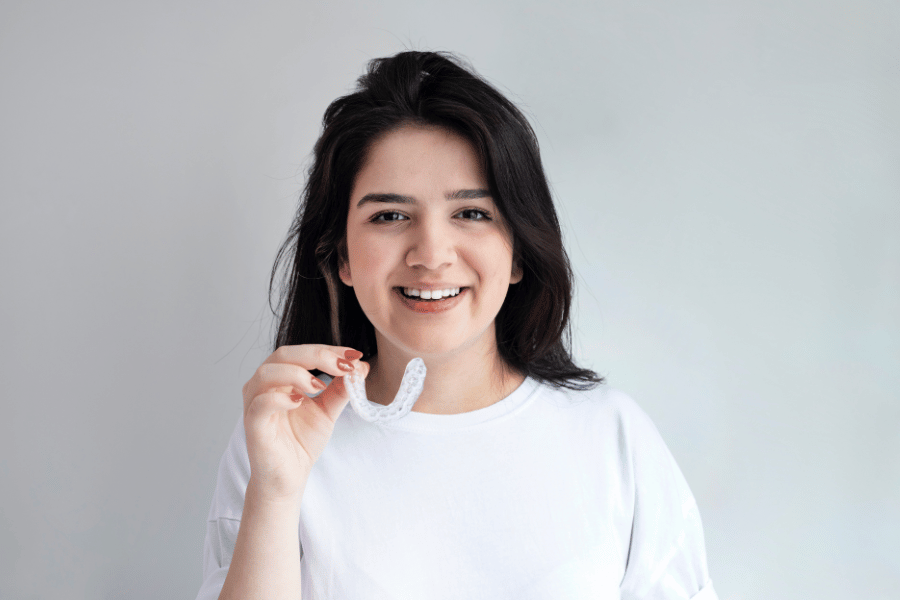
Table of contents
Proper teeth alignment plays a crucial role in maintaining oral health and overall well-being. However, many people are unaware that teeth alignment can impact their breathing.
The Link between Teeth Alignment and Breathing Problems
Teeth alignment refers to the positioning of teeth with the jaw and surrounding structures. When teeth are correctly aligned, they fit together harmoniously, promoting optimal oral function and overall health. On the other hand, misaligned teeth can lead to several issues, including breathing problems.
One of the primary ways teeth alignment affects breathing is through its impact on the development of the jaw and airway. Malocclusion, or misalignment of the teeth, can result in a narrow jaw, crowded teeth, and a restricted airway.
The following structural abnormalities can contribute to various breathing problems;
Sleep Apnea
Sleep apnea is a common breathing disorder that causes pauses in breathing while sleeping. Misaligned teeth can lead to a constricted airway, causing breathing interruptions and obstructive sleep apnea.
Snoring
Misalignment of the teeth can also contribute to snoring. When the upper and lower teeth do not fit together correctly, it can result in a narrower air passage, leading to vibrations and snoring sounds during sleep.
Mouth Breathing
Malocclusion can make it difficult for individuals to breathe through their nose, forcing them to rely on mouth breathing. Mouth breathing can be less efficient and lead to dry mouth, increased susceptibility to infections, and decreased oxygen intake.
Methods to Align Teeth
Braces
Traditional braces are a well-established method to correct teeth misalignment. They are made up of metal brackets that are attached to the teeth and are linked by wires. Over time, these wires apply gentle pressure to gradually move the teeth into the desired position. Braces are highly effective but require regular adjustments and can be visible during treatment.
Clear Aligners
Clear aligners have gained popularity as an alternative to traditional braces. These custom-made, transparent aligners are nearly invisible and can be removed for eating and oral hygiene. Clear aligners gradually shift the teeth into alignment, and the treatment progress is monitored by a dental professional.
Retainers
Retainers are often used after braces or clear aligner treatment to maintain the teeth in their new position. They might be removable or fixed, depending on the demands of the individual. Retainers play a vital role in preventing teeth from shifting back to their original misaligned positions.
Other Orthodontic Appliances
In some cases, other orthodontic appliances may be recommended to correct specific alignment issues. These appliances include palatal expanders, which widen the upper jaw, and headgear, which applies external forces to guide jaw growth and tooth movement.
Oral Habits and Breathing Improvement
Tongue and Lip Exercises
Specific exercises and postures can help strengthen the tongue and lip muscles, promoting proper breathing and alignment of the teeth and jaws.
Nasal Breathing Techniques
Nasal breathing is essential for optimal oxygen intake. Practicing breathing exercises and techniques that enhance nasal airflow can improve breathing patterns and overall well-being.
Myofunctional Therapy
Myofunctional therapy involves exercises that target the muscles of the face, tongue, and throat. It aims to correct improper muscle function, leading to improved breathing and overall oral health.
Conclusion
Proper teeth alignment is not only essential for a beautiful smile but also for maintaining optimal breathing and overall health. If you are experiencing breathing difficulties or suspect that your teeth alignment may be affecting your breathing, consult with a qualified orthodontist who can provide the appropriate treatment options for you. Remember, a healthy smile goes beyond aesthetics – it can significantly impact your overall well-being.
FAQs
Can misaligned teeth cause breathing problems?
Yes, misaligned teeth can contribute to breathing problems. When teeth are not properly aligned, it can result in a misaligned jaw or a narrow dental arch, which can affect the tongue's position and impact the airway. This can lead to conditions such as sleep apnea, snoring, and difficulty breathing during sleep or while awake.
How does teeth alignment affect breathing?
The alignment of teeth plays a role in the overall structure and positioning of the jaw and airway. When teeth are crowded or misaligned, it can result in a narrower dental arch, reducing the space available for the tongue. This can lead to the tongue being pushed backward, obstructing the airway and causing breathing difficulties.
Can orthodontic treatment improve breathing problems?
Yes, orthodontic treatment can help improve breathing problems associated with teeth misalignment. By properly aligning the teeth and jaw, orthodontic interventions like braces or aligners can create more space in the dental arch, allowing for better tongue posture and airway expansion. This can alleviate breathing issues and improve overall respiratory function.
Are breathing problems only related to teeth misalignment?
While teeth misalignment can contribute to breathing problems, it is not the sole cause. Other factors, such as nasal congestion, allergies, or structural issues in the airway, can also affect breathing. However, addressing teeth alignment through orthodontic treatment can be beneficial in reducing the impact of misalignment on breathing.
At what age should breathing problems related to teeth alignment be addressed?
Breathing problems related to teeth alignment can be addressed at any age, but early intervention is often recommended. Orthodontic evaluations are typically done during childhood or adolescence, as this is when teeth and jaw development is still ongoing. However, even adults can benefit from orthodontic treatment to improve their breathing and overall oral health. It is best to speak with a dentist or orthodontic professional to establish the most effective treatment options based on specific circumstances.